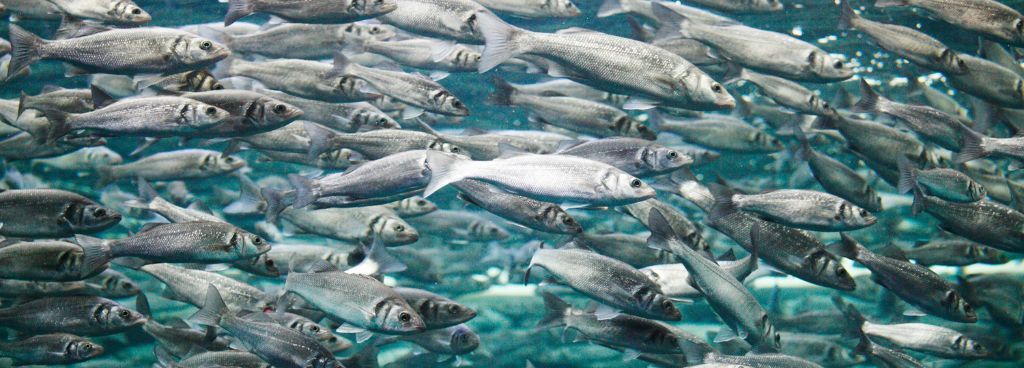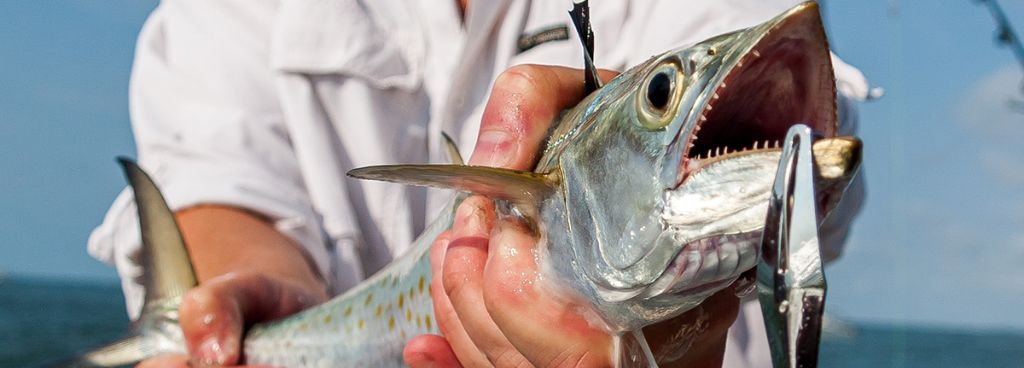Stories Worth Reeling In...
Last Updated on September 24, 2024
If you’re getting into the world of fishing, mackerel fishing is a pretty thrilling place to start. Mackerel are speedy and spirited, making the chase and catch all the more exciting. Whether you’re on a pier, a boat, or even casting from the shore, mackerel offers an accessible and dynamic fishing experience.
The key to successful mackerel fishing lies heavily in the bait you use. The right bait can make your trip memorable with a catch that’ll leave you bragging for weeks. The wrong bait?
Well, that could mean you’re left with little to show for your efforts. Crafting that perfect bait strategy? It’s more like an art than science.
Table of Contents
First, mackerel are plentiful and can often be found in large schools. This means more opportunities to reel in multiple catches. Additionally, they’re not just abundant; they’re aggressive biters, which adds a nice layer of excitement. And hey, let’s not forget they’re quite tasty and versatile in the kitchen.
Now, let’s get to the heart of the matter: choosing the right bait. This is where the magic happens. The bait you select directly impacts your success rate on the water. Natural options like ragworm, sandeels, and mackerel strips have their own appeal and effectiveness. On the flip side, artificial lures like feathered Sabiki rigs and silver spoons can offer equally fantastic results. It’s all about knowing when and where to use each type.
To wrap it up, mackerel fishing isn’t just about luck. It’s about knowing your stuff and making informed choices, especially when it comes to bait.

Ready to level up your mackerel fishing game? The bait you choose plays a massive role, and different types can be game-changers depending on the situation.
Let’s break down the best natural and artificial baits for mackerel fishing.
Natural bait options are always a hit and for a good reason. Ragworm, sand eels, and mackerel strips each have their own unique benefits.
Ragworm: A top choice because its scent and movement are irresistible to mackerel. Great for murky waters where visibility isn’t the best. Simply hook them through one end and let them wiggle to attract those fish.
Sandeels: Mackerels love these because they look just like their natural prey. Sandeels are fantastic in clear waters where mackerel can spot them from a distance. Use them fresh and make sure they’re lively on the hook.
Mackerel Strips: It might sound counterintuitive, but mackerel love chomping down on pieces of their own kind. These strips are perfect for attracting bigger mackerel. Slice the mackerel into strips and hook them through the top for the best results.
Artificial lures can be just as effective and are often easier to manage. Here are two top picks: Feathered Sabiki rigs and silver spoons.
Feathered Sabiki Rigs: These multi-hook rigs mimic small fish, making them a magnet for mackerel. Best used in deeper waters where mackerel schools are hanging out. Just drop them in and jiggle the line to entice bites.
Silver Spoons: These lures reflect light, which catches the attention of mackerel, especially on sunny days. Cast them out and reel them in quickly to mimic the erratic movement of fish. The flash and movement combo is a killer way to attract bites.
Knowing when to use natural baits versus artificial lures can be a bit of a balancing act. Natural baits tend to work better in murky or choppy waters where scent plays a big role, while artificial lures excel in clear water and sunny conditions where visibility is essential.
Choosing the right bait is just part of the equation. Knowing when and where to use it separates the casual anglers from the seasoned pros. From the best seasons to the influence of tides and water conditions, here’s how to make the smartest bait choices.
Mackerel fishing really heats up during the warmer months, particularly in the summer. These fish are more active in the warmer waters, so your chances of a good catch go up. Therefore, planning your fishing trips around these peak seasons can make a big difference.
During these periods, mackerel are more likely to go after shiny, fast-moving artificial lures like silver spoons and feathered Sabiki rigs.
But it’s not just about the seasons. Tides and water conditions can either make or break your fishing day.
When it comes to tides, mackerel often feed more aggressively during moving tides—both incoming and outgoing. Your bait choice can capitalize on this. During high tides with strong currents, artificial lures are usually more effective because their movement can mimic that of a struggling fish in rough waters.
Conversely, during calmer conditions, natural bait like ragworm or sand eels will work wonders since the scent can linger and attract fish more effectively.
Water clarity also plays a role. Clear waters are perfect for using those reflective silver spoons because the light refraction mimics the flash of smaller fish. On the other hand, murky waters are ideal for natural bait that rely on scent rather than visibility. Ragworm and mackerel strips are standout choices here.
Location matters too. Coastal areas, piers, and jetties are popular spots for mackerel, and the right bait can make these spots even more productive. If you’re fishing from shore, try using natural bait for its scent and appeal.
On a boat? Break out the artificial lures and cover more ground to locate those schools of mackerel.

There are a number of important factors to take into account when selecting the The bait is only as good as how you use it, right?
Knowing the right techniques can skyrocket your catch rate. Let’s look at some key methods for making the most out of both natural and artificial baits when fishing for mackerel.
When using natural bait, trolling is a technique worth mastering. Trolling involves dragging the bait behind a slowly moving boat.
You’ll want to rig your bait properly so it looks alive and attractive. Hook your ragworm or sand eel through the nose or tail, allowing it to move naturally in the water. The bait’s movement, combined with the boat’s speed, makes it irresistible.
Make sure to vary your trolling speed to see what gets the best bites.
Casting and jigging are two other techniques to get familiar with, especially if you’re working with artificial lures. Casting involves throwing your lure out into areas where you suspect mackerel might be lurking.
Once the lure hits the water, reel it in at varying speeds to mimic a live fish. Jigging involves dropping your lure straight down and then creating an up-and-down motion with your rod.
Feathered Sabiki rigs work well for this, as their multiple hooks can catch more than one mackerel at a time.
Practicality is key here. For trolling, having a sturdy rod and a reel with a smooth drag system is essential. You’ll need this for handling the resistance as you move. Meanwhile, for jigging and casting, a medium-action rod with good sensitivity can make a world of difference. You’ll not only feel the bite but also set the hook more effectively.
Another pro tip is to pay attention to the behavior of the fish around you. Mackerel often follow schools of smaller fish. If you notice baitfish jumping or scattering, that’s your cue to get your lure or bait in the water quickly.
Mimicking the size and color of these baitfish in your lure selection can pay off big time.
Having the right tackle and gear is crucial. Mackerel are feisty fighters, so you need equipment that can handle their spirited runs. Let’s talk about the essentials: rods, reels, and the tackle setups that pair perfectly with your bait.
When selecting rods and reels, versatility is key. For trolling, a medium to heavy action rod combined with a high-capacity reel with a good drag system is ideal. You want a rod that can handle the constant tension and a reel that can hold enough lines to let you cover more water. A 7 to 9-foot rod with a 20-30lb test line usually does the trick. This setup is robust enough to manage the pull and twist of a hooked mackerel while trolling.
Casting and jigging require different gear. A medium-action spinning rod works best for these techniques. Look for a rod around 6 to 7 feet long with a fast action to help detect the subtle bites and set the hook quickly.
Pair this with a spinning reel that has a smooth drag and a high gear ratio, which helps reel in your catch swiftly to ensure it doesn’t escape. A 10-20lb test braid line is generally a great choice for casting and jigging, offering you both sensitivity and strength.
Your tackle setup needs the right accessories too. For natural bait, equip your line with a fish-finder rig or a simple sliding sinker rig. This allows your bait to move more freely and attract mackerel more effectively.
If you’re using artificial lures, a swivel is essential to prevent your line from twisting. Feathered Sabiki rigs can benefit from additional split shot weights to ensure they sink quickly and effectively reach the mackerel school.
A well-stocked tackle box is a must. Include extra hooks, sinkers, swivels, and a variety of lures and baits. Have pliers handy for removing hooks and a net for landing your catch.
Don’t forget a tackle box with compartments to keep everything organized, so you’re not fumbling around when the action heats up.
Investing in quality gear pays off. Not only does it make fishing more enjoyable, but it also increases your chances of bringing home a big haul of mackerel. From rods and reels to the smallest swivel, every piece matters.

Embarking on your mackerel fishing journey is an exciting adventure and plenty of learning opportunities. Through understanding the best bait types, knowing when and where to use them, and employing effective techniques with the right gear, you’ve got a solid foundation for success. Just remember, each trip is a chance to refine your skills and adapt to the ever-changing conditions of the water.
Curiosity often leads to common questions that can help both beginners and seasoned anglers alike. Here are some frequent queries that arise among mackerel enthusiasts:
Typically, summer is the prime time for mackerel fishing. Warmer waters bring mackerel closer to the shore, making them more accessible. Early morning and late afternoon are particularly fruitful times.
Mackerel can be attracted to both, depending on the conditions. In murky waters, natural bait like ragworm might be more effective due to its scent. In clearer waters, artificial lures that reflect light can be just as enticing.
Mackerel often swim in mid-water depths. Depending on the season and water conditions, they can be found anywhere from just below the surface to about 20 meters deep. Adjust your bait depth accordingly.
Absolutely. Piers, jetties, and rocky shorelines are excellent spots. Using lighter gear and casting your bait as far out as possible can increase your chances of a catch.
Each question offers a nugget of wisdom, helping to streamline the process and make you a more effective angler.
Enjoy the process, stay curious, and make every fishing trip a story worth telling. Tight lines!